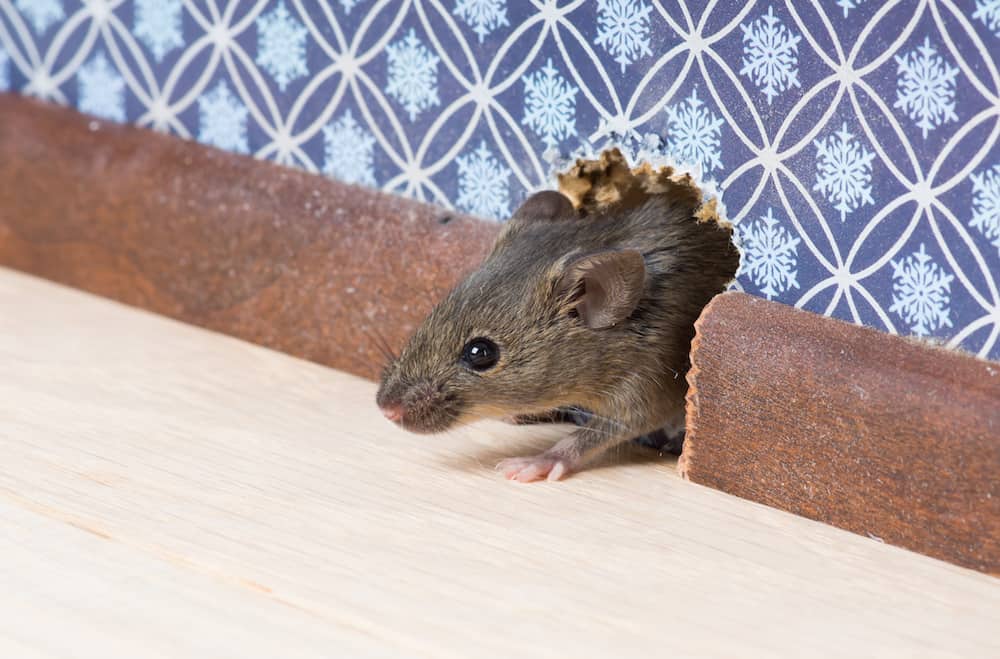How prevalent are rodents inside homes during the fall and winter months? According to the National Pest Management Association, 21 million homes in the United States will report a rodent infestation, primarily house mice, in the coming months.
Cooler weather is prime time for rodent incursions into homes, apartments and other structures. Rodents, like most pests, simply want a warm place that is in proximity to readily available nesting materials and food. Cooler temperatures and inclement weather also reduce available the natural food sources that rodents rely on.
The House Mouse
The main culprit of these incursions is the cagey house mouse. Mice will carefully explore a home using wall voids, utility pipes and wires, and heating and cooling duct work in search of their next meal. Wall and cabinet voids near kitchen appliances (i.e., refrigerators, dishwashers, stoves, etc.) and the pantry serve as popular nesting sites.
Mice are patient interlopers that are also opportunists. They will wait for the right occasion – a door left propped open, being a stowaway in a box of off-season clothes brought in from a storage area or squeezing through a dime-sized opening in the foundation or next to a door frame – to gain access to your home.
Rottler Pest Solutions has long battled this tiny and elusive adversary and wants to share information on common signs of a mouse infestation, where they are most likely to be spotted and how best to prevent an infestation from taking place.
Signs of Mice
- Rodent droppings (usually black in color and ¼ to ½ inch long) and urine (best detected using a black light).
- Chewed electrical, computer or cable wiring (a major cause of electrical fires).
- Unexplained chewing or gnaw marks on carpet, upholstery, drapes, furniture and baseboards.
Where Mice Live
In addition to the kitchen, what areas of your home are most vulnerable to attracting an unwanted rodent infestation? Rodent hot spots include:
- Garages, sheds and storage areas above these locations where storage boxes, pet food and other items are found.
- Bathroom cabinet voids.
- In utility rooms and areas beneath, and within base voids of furnaces, washers and clothes dryers.
- In wall, ceiling and floor voids.
- In the insulation of attics and in the contents of the attic (i.e., storage boxes)
- In basements and crawlspaces near utility openings.
- Firewood stacked next to an entry door and in brush piles in the yard.
Rodent Exclusion Tips
Preventing rodents from gaining access to your home starts with creating an impenetrable rodent barrier around it.
- Seal cracks in the foundation of your house or utility pipe openings with caulk or other appropriate materials.
- Check the weather stripping around exterior doors to make sure there are no gaps.
- Inspect wires, insulation and walls for gnaw marks, which may indicate a rodent infestation.
- Store boxes off the floor to prevent rodents from residing in undisturbed areas.
- Keep branches and shrubbery trimmed and away from the house. Roof rats will use branches to access openings on your roof to get inside your attic.
- Store firewood at least 20 feet from the home and five feet off the ground.
- Keep garbage and recycling can lids closed and take out the garbage on a regular basis.
- Do not leave food out on counters or in the pantry and pick up pet food bowls – rodents love pet food.
Contact Rottler Pest Solutions
Rottler can help keep rodents from gaining access to your home this fall and winter with proven exclusion and control programs. Protect your home today scheduling a free rodent inspection today, or calling 877-768-8537.


